FreeFrom软件操作说明
FreeForm分模功能详细说明FreeFormModelinglus软件教程

Mold DemoCreating Parting Line: Load the included Vampire Boy model.Go to Tab > Moldable PartCreate a parting line curve by activating the mold toolbar feature by selecting theMoldable Part tab. Then click on the Parting Line Curve icon on the toolbar andFreeform Mold Demo -1-click on the Show Parting Line Color icon to show the parting line. The arrow on the screen indicates the mold pull direction. You can change the direction by clicking onthe Set Direction icon to check the best parting line solution. Once everything is set, click on Apply to create the parting line curve.The parting line curve direction is already set for this model, but be sure the parting line draft angle is set to zero. To check if the draft angle is set to zero for this evaluation, go to Tools > Option > Parting line draft angle. For using the Parting Line tool, always set the draft to zero so that you will get a clear blue line. If the draft is not set to zero, the parting line curve will not be created in the correct location.Currently, the mold pull direction is already set correctly. If you want to show people the different pull direction, click on the Set Direction icon to change the setting.Showing Curvature PlotFreeform Mold Demo -2-The parting line curve is very dense and trying to pick up all the details necessary. If you want to look at the level of quality of the parting line curve, you can turn on the curvature plot and create a curvature plot of each curve. Go to:View > Design Curves -> Create Curvature Plots. Then click on the parting line curves on the model. By default, the plot is set in 2D to show the noise in Z direction only; you can also set to show the noise in X and Y direction by changing the 2D Curvature icon to 3D Curvature icon on the Dynabar. [as shown below]2D curvature plot showing on noise in Z directionFreeform Mold Demo -3-3D curvature plot showing noise in X and Y directionIn most cases, you will only want to use the 2D curvature plot in the Z direction. The number shown on the curvature plot indicates the minimum radius curvature of the curve. This number can be used to determine the tool size for machining in the future. To find the tool radius, simply take the inverse of the curvature value. The equation used in this calculation is shown below:C = 1/R ; C = curvature, R = radiusEditing Parting Line CurveFreeform Mold Demo -4-machining. To avoid this problem, I am going to smooth the parting line curve. Tosmooth the parting line curve, click on the Select icon on the toolbar and then clickon the parting line curve. Change the number on the Points box to reduce thenumber of points on the curve. In most cases, you can reduce the number of point by halfthen refit it. Be aware that it may have drifted from sharp details in the XY plane.Usually, after reducing the points on the parting line, the parting line will likely still be very close to the original parting line. However it does not work for every case. In most situations, you can just reduce the points and refit it just for demo purposes.Now I will refit the parting line curve by clicking on the Fit CurveFreeform Mold Demo -5-to Clay tool under the same flyout as the Parting Line Curve tool. Then click on the parting line curve. Refitting the curve will remove the curvature plot information because the refitted curve is actually a new curve. Therefore, you have to put the curvature plot back on to see the new result. Now you can see that the refitted curves have a low curvature and noise.You can also use the Smooth Curve tool under the Parting Line Curve tool to smooth out the curves. After you are satisfied with the result, you can turn off the curvature plot.Fixing DraftFor this model, there is a draft problem. To demonstrate the draft-fixing feature, youFreeform Mold Demo -6-should point out some draft problems on the model. Indicate the areas behind the nose and the teeth (Create Parting Line actually surrounded these areas with curves, which can be deleted at this time.)The next thing to do is to fix draft. As you can see on the screen, the nose and the tooth have a draft issue. To correct the problem, I can either add material or remove material to correct the problem under the Draft option.Go back to create moldable part and then select Draft tool on the toolbar. Then click on the parting line. The problem areas are shown in blue. Now I want to add material behind the nose to the fix the draft instead of chopping off the nose to fix the draft. So I click on the Add Clay , but hold to the parting line by clicking thePreserver Parting line icon then click Apply.The changes on the model should be very quick, so you can say a few words or gesturing with your hands, then the changes should be done. The fixed model is shown below.Freeform Mold Demo -7-Shelling The ModelClick on the “d” key to show the model in See Through mode, and indicate that it is a solid model. Click the “d” key once more to return to an opaque view.Now you can shell the model. Click on Shell on the toolbar. For this model, I want a 4mm shell. Then change the number in the Shell Thickness box on the dynabarto 4 and click Apply.Freeform Mold Demo -8-The shelling process should be done very quickly. While waiting for the model to be shelled, you can talk about the benefit of this feature. After the shell is complete, click on “d” on the keyboard again to activate the dotted mode for showing the part thickness.Click “d” to change to dotted mode to show part thicknessYou can check the part thickness by using the ruler feature. Go to Tools > Ruler or click“r” on the keyboard to activate the ruler feature. Then select Measure Thicknessicon on the Dynabar and measure the part thickness.Freeform Mold Demo -9-Creating Split JointFor better visual, turn off the clay by clicking on Blank Clay icon. The resulting screen is shown above. By turning off the clay, you can see the glue joint that you will create on the screen.Now I want to be able to create the shiplap joint. I go down to the Split Joint tool and pick on the curve on the screen. It will create a butt joint by default first (shown below) then I will create a shiplap joint on the modelFreeform Mold Demo -10-.After selecting the curve on the screen, a butt joint will be created. The creation of butt joint will not fail on this model. The shiplap joint properties box will pop up automatically when the butt joint is created.On the ShipLap Joint Properties box, set the values on the boxes to:-Offset value to 2mm because it’s a 4mm shiplap-Depth value to 2.5mm, just high enough that people can see the difference -Angle value to 5 degree so that it looks like in a angleFreeform Mold Demo -11-Ensure the Modify Region icon is selected on the dynabar then click on any two points on the outside curve of the model to define the region of the joint then click on any place on the curve within the region to create the split joint (as shown above).For the demo, create shiplap joint at only one place because for every place you do, you have to be able to select the inside curve of the split joint in the middle of the demo when you are doing Make Part and Make Insert. Therefore, to shorten the demo time and keep the audience’s attention, avoid creating more than one split joint.Next you want to show the Groove split joint feature, make an undo after the shiplap joint is created. Then select Groove Joint icon and the Groove Joint Properties box will appear.Freeform Mold Demo -12-Make sure the sum of the Offset value and the Width value does not exceed the width of the split joint, which is 4mm in this case. Otherwise, you will receive an error message. Once the values are entered, ensure the Create Split Joint icon is selected on the dynabar to create a groove joint on the entire curve. Then select the curve on the screen and a Groove Joint will be created (shown as below)Creating the groove joint for the demo is easier for the Make Part step later in the demo because you don’t have to pick the separate section all the way around the curve.Freeform Mold Demo -13-Freeform Mold Demo -14-Making PartNow I will separate the model into 2 parts, part 1 and part 2. I go to the Make Particon on the toolbar. Then select the Split Curve icon on the dynabar and click on the first split joint then the second split joint of the part. Next I click on the Part 1 Sideicon and click on the outside of the model(the face in this example) to select what is going to the part 1.When selecting the part 1 side, uncheck the Blank Clay to show the whole piece of clay. It’s easier in this way.Freeform Mold Demo -15-The first split joint is the outside curve of the part and the second split joint is the inside curve of the partThe first split joint is highlighted inFreeform Mold Demo -16-The second split joint is highlighted in green as shown on the rightnow look at the other part by selecting Work on Part of the other part in the Object List.Freeform Mold Demo -17-To turn on the object list, either click “o” on the keyboard or go to View > Object listOn the Object List, click on the part icon, and select Work On Part option to select the part that you want to work on.For the rest of the demo, we will work on one part of the model, Part 1 the face, though the other Part 2 can be done in a similar way.Freeform Mold Demo -18-Creating Mold InsertSo the next thing I will create an extent for the part, that is defining the actual mold insert dimensions, and create parting surfaces for the model.The extents can be resized to any dimension you need to fit into the mold. To resize it, you go to the set extents option (which is usually active when first entering the Mold Insert tab) and enter the XYZ values for the extents.To resize the extent, click on Create Mold Insert tab on the top of the workspace thenselect Mold Insert Properties and click on Set Extents icon on the Dynabar. Enter the desired dimension for the extent on the X,Y,Z boxes. For the demo, show people that the extent can be changed and set the numbers in the X,Y,Z boxes to a reasonable numbers. The following numbers are used for this demo:+X = 100.00, -X = -100.00+Y = 150.00, -Y = -150.00Freeform Mold Demo -19-+Z = 100.00, -Z = -100.00Freeform Mold Demo -20-Creating Extruded Parting SurfaceNext I will create the parting surfaces for the part. I go to the Extrude Parting Surfacetool then pick on two places on the curve to define the boundary. When you are picking the points to define the boundary, you don’t have to pick on the points, you can pick anywhere on the curve. The extruded surface can be created in a 45 degree angle. When extruding the surfaces from this example, extrude the surfaces perpendicularly from the form. For example, extrude it in a horizontal or vertical direction.Freeform Mold Demo -21-Creating Insert BlocksAfter the parting surface is completed, I will create a core insert block and a cavity insert blocks for the part. This can be done in a few steps.First I go to the Make Insert Blocks tool on the toolbar. Second, I pick the edge of the parting surface and the parting line. Finally, I select the side for the cavity block. To create insert blocks for the part:-Click on Parting Surface Curve icon on the Dynabar and select the edge of the extruded surface-Then select the parting line of the model (as shown below in green)Freeform Mold Demo -22--Click on Cavity Side icon on the dynabar and select the cavity side of the model.-Once the cavity side is selected, a plane will appear on the screen to represent the bottom of the cavity block.o Notes: Don’t zoom to close to the model; otherwise you will not be able to see the plane.o Notes: If you selected the top part as the cavity side, then the plane should be placed on the topside or on the bottom side if the bottom part isselected as the cavity side.- A window will pop up and asks if the plane is placed correctly, click “Yes” if the plane location is correct or “No” if the plane location is incorrect…Freeform Mold Demo -23-shown below)…Freeform Mold Demo -24-From here, I have two insert blocks, one for the core and the other one for the cavity. I can look at either one of the blocks by selecting it on the Object List.To look at the core block:-Turn on the object list and click on the core mold insert icon, and select Work On Component option-This will hide the cavity side component automatically.Freeform Mold Demo -25-Freeform Mold Demo -26-You can turn off “See Through Clay” option by View > Design Curve > See Through Clay for people easier to see to blockFreeform Mold Demo -27-Reverse Engineering the Core FaceThe next thing I will do is to create patch surface for the core. After I create the patches, I can export the file to other CAD software to build other components on the mold insert such as runners systems, water lines, sprues, and ejection pins, etc. To create the patch, I draw curves that defined the patch boundary on the core. Then using the Patch toolon the toolbar to create the batch surfaces for the core.Freeform Mold Demo -28-To draw curves defining the patch boundary on the core:-Select Draw tool under Parting Line tool-Ensure the Fit on Create icon is selected on the dynabaro Notes: DO NOT select Split on Create icon on the dynabar because it will destroy the surfaces by separating the curve into two-Turn on See Through Clay option by: View > Design Curves > See Through Clay (if you find it to be easier).-Start drawing curve on the model to cover up the entire core (as shown above)Freeform Mold Demo -29-To create patches on the core surface:-Once the curves are drawn on the surface, select the Patch tool-Ensure Fit to Clay and Manual Boundary Select icons are selected on the dynabaro Notes: Selecting the Fit to Clay icon will create patches that are more tightly fitted on the clay surface than using the Fit to Boundary icon . -Click on the curves in sequence to define the boundary of the patch. Once you are done the patches, go to the object list and folder the patches you create and label the folder something meaningful. You will need to refer to this folder later.Freeform Mold Demo -30-Exporting IGESOnce the Core side of Part 1 is patched, it can be exported as an IGES file for further modification in other CAD software.To export an IGES file of the Core side:Go to File > Export > Curves and Patches, then check the following information in the dialog box that appears:Freeform Mold Demo -31-…which will write an IGES file for CAD import. To export an STLfile of each of the blocks of the insert, for rapid prototyping:For the core, turn off the display of all Clay and Curves using the lower left display control:Then go to File > Export > Model, then, it will export the patches which will be subdivided to create polygons out of the patches.Usually, the default has adequate details when exporting the STL polygon file but if you want more detail, go to Patch Display Properties under the Blank Patches icon onFreeform Mold Demo -32-the Dynabar.Freeform Mold Demo -33-Changing the Display Resolution to High in thePatch Display Properties will give you a muchfiner tessellation of the patches.You can verify your results by reading the fileback in as an STL import and preview (but don’tkeep it, just preview it as below…Note: When exporting the Cavity side, you don’t want the Split Joint patches or the core face patches visible. On the Object list, do a “work on component” on the cavity component first, then hide the Split Joint Curves and Split Joint Patches folders as shown on the right. Find the folder you created for the Core face reverse engineering patches and hide it as well.Creating ElectrodeCreating electrode off the cavity is not something that is automatically created but it is not too difficult to do. First you want to turn off the surfaces and build a plane to project the parting line onto the plane. Then draw a line to connect the curves and create a patch for the side. Once the patch is created, export it as an electrode.To Create Electrode Off the Back Cavity Block:Go to the Object list then turn off the surfaces of the core and cavity blocks and the parting surfaces as shown below.Then select New Plane/Sketch on the toolbar to create a plane. The distance between the part and the plane is equal to the distance of the side of the electrode.Select Project Curve to Plane from the flyout of the Parting line curve tool on the toolbar. Then click on the parting line curves and touch the plane. The curves will then be projected onto the plane (as shown below). Once the curve is projected, you can hide the plane on the object list.Freeform Mold Demo -34-Next select Draw from the Parting line curve tool on the toolbar. Make sure the Fit on Create icon on the dynabar is deselected because you want to make a square patch. Then draw a line connected the parting line and the projected parting line.For this model, a patch can be built with only two main curve segments (as shown below)Freeform Mold Demo -35-Freeform Mold Demo -36-dynabar so that a straight extrusion can be created. Then select the curves in sequence to create the patches (as shown below)Once the side patches are created, you can make a patch for the back but for electrodes the back patch is not required. Then export it as an STL file for tooling the electrode.。
FreeForm软件教程-V10新增功能详解
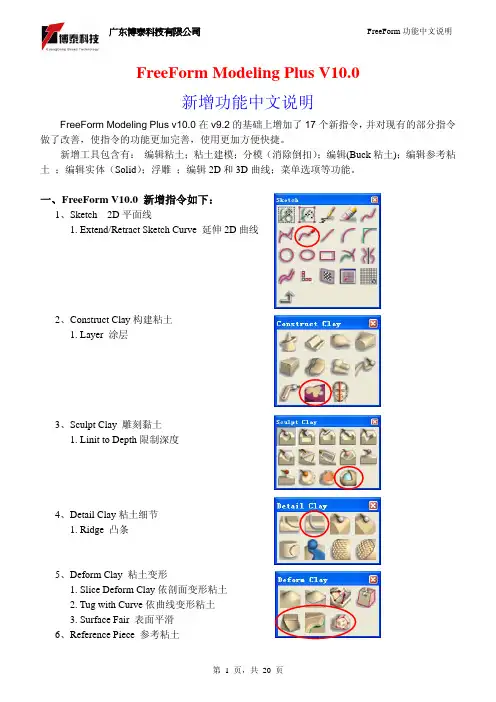
Thickness – 在凸条底面延长一个厚度。
第 4 页,共 20 页
广东博泰科技有限公司
FreeForm 功能中文说明
勾选
不勾选
Profile Orientation 方向定位
Clay Surface
依粘土表面方向计算
Buck Surface
依 Buck 粘土表面方向计算
二、新增指令功能详细说明:
第 2 页,共 20 页
广东博泰科技有限公司
FreeForm 功能中文说明
Sketch:
1、
Extend/Retract Sketch Curve 延伸 2D 曲线
曲线的延伸方式
延长现有的曲线 延长的部分成另一条曲线
曲线长度
细部说明:
Tangent Reflection Curvature Tangent(to point)
缝合
不勾选时将在当前的参考粘土上进行缝合;勾选时将 Copy 一个参考粘土层 第 8 页,共 20 页
广东博泰科技有限公司
Example
FreeForm 功能中文说明
2、
Slice Deform Reference 依剖面变形“参考粘土”
注:(此指令用法同上,区别只是在于一个针对粘土,一个针对“参考粘土”,
3、
Plane to Clay Intersection Curve 粘土和平面求交线
软件自动计算编辑点数量
使用最大限度
直接设定编辑点数量
使用默认的控制点数量
使用最大限度
直接设定控制点数量
剖面公差
4、
Surface to Clay Intersection Curve 曲面和粘土求交线(其选项菜单同
FreeFrom软件操作说明
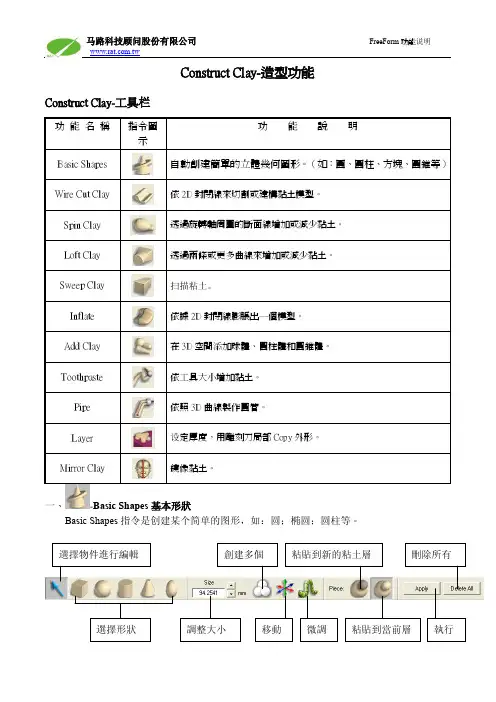
Construct Clay-造型功能Construct Clay-工具栏一、-Basic Shapes 基本形狀Basic Shapes 指令是创建某个简单的图形,如:圆;椭圆;圆柱等。
二、Wire Cut Clay形体切割功能01.当2D 平面上有绘制任何的2D线段,我们可以使用Wire Cut Clay来挖除所需的深度。
02.点选Wire Cut Clay后,再点选2D Sketch上的线条。
03.请在下列的对应工具栏中,输入所要挖除的深度。
输入所要挖除的深度Raise Lower04.再点选Lower指令,即可完成挖除的动作。
※亦可选择Raise来长出对象。
使用Wire Cut Clay設定深度,完成切割動作。
05.选择距离的计算方式。
边界的斜度依据两个平面的距离计算依据第一个平面与粘土之间的距离计算06.Wire Cut Clay除了可以切割深度外,也可以切割对象外观。
Create Inside在线段范围内长出材料Cut Inside切除线段范围内的材料Cut Outside切除线段范围外的材料三、Spin Clay依2D线旋转粘土功能制作在另外一个层制作在当前层长出粘土切除粘土隐藏/显示2D平板01.开启新的绘图平板,并在上面绘制欲建构模型的断面线及中轴线。
02.点选Spin Clay功能,选择Create Inside选项,以建构出所要的模型。
※斷面線必須為封閉線段,中心轴必须是直线。
四、Loft造型功能點選繪圖平板載入導引線預覽載入斷面調整導引線取消01. 使用Loft功能時,必須先使用2張以上的繪圖平板繪製出輪廓斷面線,並設定距離。
02. 點選Select Ste p,選擇上一步驟所定義的輪廓線,將出現下圖的預覽結果。
03. 點選Section Ste p,可在模型任意位置載入新的斷面線。
04. 點選Guide Ste p,可在斷面線之間載入導引線。
05. 點選Shape Ste p ,可根據所需造型進行斷面線和導引線的調整。
FreeFrom软件操作说明
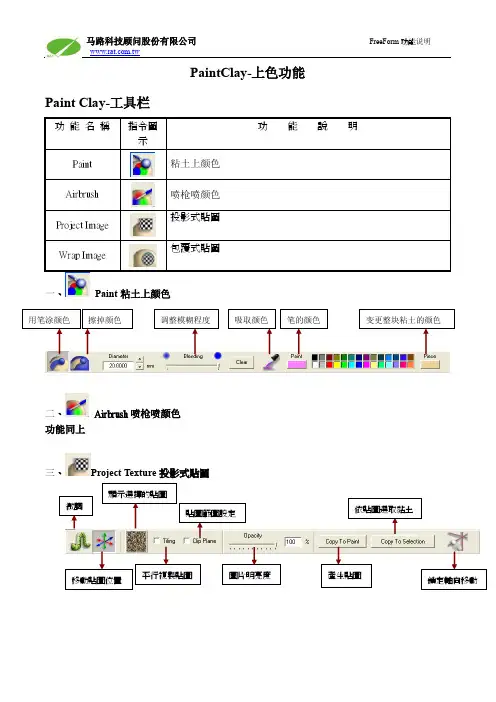
FreeForm 功能说明
PaintClay-上色功能 Paint Clay-工具栏
功 能 名 稱 指令圖 示 粘土上颜色 喷枪喷颜色 投影式貼圖 包覆式貼圖 功 能 說 明
Paint Airbrush Project Image Wrap Image
FreeForm 功能说明
細部說明: Tiling Clip Plane Opacity Copy to Paint Copy to Selection 勾選此選項時,圖片自動復制,使整個物件上色 通過調整平面的位置來控制上色範圍,此選項在 Tiling 時無法使用 調整圖片的明亮度,數字 1 代表 10%,其它數字依此類推﹔也可以在后直接 輸入數字來精確控制圖片的亮度 將圖片顏色復制在黏土,若再對黏土進行編輯,顏色有可能會丟失 通過圖片顏色選取黏土,可能選擇黏土進行復制等動作,可視為另一種選取黏 土的方式
一、
用笔涂颜色
Paint 粘土上颜色
擦掉颜色 调整模糊程度 吸取颜色 笔的颜色 变更整块粘土的颜色
二、 功能同上
Airbrush 喷枪喷颜色
三、
Project Texture 投影式貼圖
顯示選擇的貼圖 微調 貼圖範圍設定 依貼圖選取黏土
移動貼圖位置
平行複製貼圖
圖片明亮度
產生貼圖
鎖定軸向移動
马路科技顾问股份有限公司
四、
Wrap Texture 包覆式貼圖
產生貼圖 微調 單一色彩貼圖 依貼圖選取黏土 清除
自訂貼圖
貼圖尺寸
移動圖片位置
使用 Copy To Paint 時黏 土精度為 2mm 的結果
使用 Copy To Paint 時黏土 精度為 0.25mm 的結果
FreeFrom软件操作说明
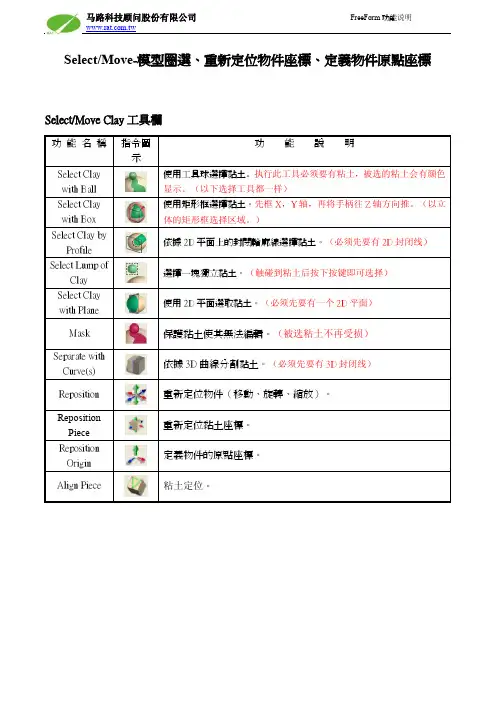
Select/Move-模型圈選、重新定位物件座標、定義物件原點座標Select/Move Clay工具欄
一、Mask模型表面遮罩
Mask指令是用來定義粘土的屬性(使粘土無法編輯)。
使用者自定義選擇使用圖片來圈選
二、Reposition Piece:重新定位物件座標
座標位置微調旋轉鎖定在世界座標系移動
平移軸向鎖定鎖定在物件座標系移動離開三、Reposition Origin:重新定位原點座標
座標位置微調平移軸向鎖定鎖定在世界座標系移動
設定原點座標於重心位置旋轉鎖定在物件座標系移動鎖定在曲面法線
方向
四、Align Piece:粘土定位
当粘土定位时,可在粘土或3D曲线或2D Plane上面任意选三个点来定义一个平面,然后再以这个平面为基准转到某一个方向;也可直接根据轴向来定义方向;同时可以使用Object菜单里现有的2D Plane为基准来定位,这样会比选三个点定位更方便。
FreeFrom软件操作说明
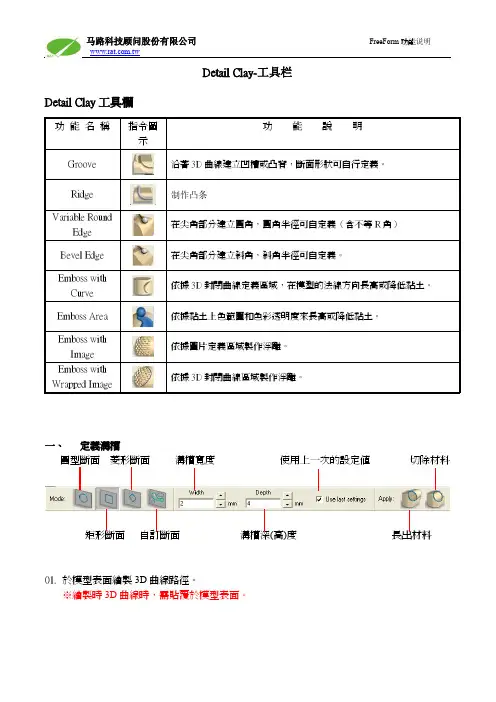
Detail Clay-工具栏Detail Clay工具欄一、定義溝槽圓型斷面菱形斷面溝槽寬度使用上一次的設定值切除材料矩形斷面自訂斷面溝槽深(高)度長出材料01.於模型表面繪製3D曲線路徑。
※繪製時3D曲線時,需貼覆於模型表面。
02. 點選Groove定義溝槽功能,選擇上一步驟的3D曲線,並設定所需的寬度、深度或高度。
03. 選擇Create Inside(長出材料)或Cut Inside (切除材料),設定結果是要長出溝槽或是挖除溝槽。
上圖為Cut Inside (切除材料)的結果上圖為Create Inside(長出材料)的結果二、 Ridge 击条三、 倒R 角Variable Round Edge 指令是依據參數的控制倒不等R 角,同時可任意增加斷面來控制中間部分。
四、倒直角Bevel Edge 指令是依據參數的控制倒45°的斜角。
1、不勾選此選項:2、勾選此選項:五 、模型外觀OffsetOffset 高度或深度設定 往下Offset 沿著模型法線方向Offset往上Offset 沿著模型法線平均方向Offset02. 於模型表面繪製3D 曲線範圍。
※繪製時3D 曲線時,需貼覆於模型表面。
2. 點選Raise(往上Offset)或Lower(往下Offset)進行曲線範圍的Offset,並可選擇Normal To Surface或Average Surface Normal設定不同的結果。
上圖為設定成Normal To Surface(沿著模型法線方向Offset)的結果上圖為設定成Average Surface Norma(沿著模型法線平均方向Offset)的結果六、依照顏色長高或降低粘土(Emboss Area)Apply Texture to Rendering Plane指令是在Render Image 時設定背景圖片。
調整Falloff調整Opacity使用FreeForm 製作浮雕有兩種方法: 方式一:Emboss With Image工具栏方式二:Emboss With Wrapped Image 依曲线定义边界制作浮雕此種浮雕製作方式和上一種是不同的,此方式是先將影像貼附在3D模型表面上,之後再計算3D 立體浮雕。
FreeFrom软件操作说明
Patches/Solids-曲面和實體Patches/Solids工具欄一、鏡射曲面和實體Mirror Patch指令可以鏡射一個或多個曲面或實體。
二、將曲面模型縫補成實體模型Stitch 指令是將多個曲面(Patch)縫補成一個實體(Solid)。
點選Stitch 命令後,使用步驟及方法說明如下圖。
三、改變曲面顯示模式Patch Display Properties 指令是利用貼圖的方式來檢測曲面的順滑程度。
四、產生曲面Create Patch 指令是先規劃好曲面邊界線,再舖成曲面。
曲面和實體轉換功能說明五、將曲面或實體模型轉換成黏土Convert to Clay 指令是可將實體(Solid)或曲面(Patch)轉換成黏土,點選Convert to Clay 命令後,使用步驟及方法說明如下圖。
六、利用3D 曲線分割黏土網格Split Mesh 指令是依據封閉的3D 曲線,進行模型STL 資料的拆解。
七、利用3D 曲線修剪曲面Trim Patch 指令是用封閉的3D 曲線將曲面做裁剪的動作。
點選Trim Patch 命令後,會出現如下的工具列,說明如下圖。
八、 Wire Cut Solid :切割/擠出實體Wire Cut Solid 指令是用封閉的2D 線切割或擠出實體。
點選Wire Cut Solid 命令後,會出現如下的工具列,說明如下圖。
建構說明:九、Spin Solid:旋轉實體Spin Solid指令是利用封閉的2D斷面線繞著一個旋轉中心軸旋轉出實體。
使用方法及步驟說明如下圖。
十、 Loft Solid :斷面拉伸成實體Loft Solid 指令是用兩個平面以上的封閉2D 線拉伸成實體。
點選Loft Solid 命令後,使用步驟及方法說明如下圖。
調整控制點十一、Rail Solid:掃出實體Rail Solid指令是利用2D輪廓線沿著3D線路徑掃出實體或溝槽。
點選Rail Solid命令後,使用步驟及方法說明如下圖。
FreeFrom软件操作说明
Curves- 3D線工具Curves工具欄一、 繪製3D 曲線Draw Curve 指令是在3D 的空間畫線。
二、 投影3D 曲線至模型表面三、 Split 任意分割曲线Split Curve 指令是分割曲線。
注:使用第一项打断曲线时,可按住Ctrl同时选中多条线,再选定一个点进行分割。
四、合併3D 曲線Combine Curve 指令將兩條曲線合併成單一曲線。
步驟一:先單擊要合併的其中一條曲線。
步驟二:選取另外一條曲線。
工具使用說明:五、抓取断面线產生單條剖面線剖面線數量反向設定產生多條剖面線剖面線間距確認1. 產生單條剖面線01. 點選Create Plane新增繪圖平板,並調整平板至所需產生剖面線的位置。
02. 點選產生單條剖面線的功能,然後點選Apply確認。
03. 如下圖所示,剖面線將會產生在2D繪圖平板和模型的相交處。
2. 產生多條剖面線01. 點選Create Plane新增繪圖平板,並調整平板至模型的邊緣。
02. 點選產生多條剖面線的功能,然後設定剖面線數量及剖面線間距,即會出現下列預覽畫面,方向若不正確,請點選Flip進行反向設定。
03. 點選Apply確認,即可產生如下圖所示的多條剖面線。
04. 若需在不同軸向產生剖面線,請在不同軸向新增繪圖平板,然後重複上述步驟即可產生不同軸向的剖面線。
六、產生3D交線01. 於2張不同的2D繪圖平板上繪製所需的輪廓線。
02. 點選Intersect Sketches產生3D交線功能,使用兩張2D平板上的輪廓線段,產生3D交線。
03. 下圖為產生的3D交線。
七、3D 曲線Offset複製並Offset 曲線 往內Offset Offset 至模型表面Offset 距離 確認Offset 原始曲線 往外Offset 使用數值進行Offset 清除八、產生螺旋曲線Helix 指令是依據一條3D 曲線為中心,旋轉出螺旋線。
曲線起始的半徑 曲線終止的半徑曲線的起始角度 曲線的圈數九、 Subdivide Curve Loop曲線細分Subdivide Curve Loop 指令是繪制四條邊界線,再細分中間。
FreeFrom软件操作说明
Copy and Offset Curve,然 後點選 Offset to Outside
,接著點選 Offset by
Value
,輸入 5mm,最後
點選 Apply 即可完成分模線的平 行複製。
03.Offset 出來的 3D 曲線,可能會 有上下波動的情況,可將線段修 整平順。
马路科技顾问股份有限公司
FreeForm 功能说明
一、FreeForm 分模步驟:
1. 請開啟要進行分模處裡的公仔檔 案 FrogBoy.cly。
2. 點選
Parting Line Curvt 視角以設 定成脫模方向。
马路科技顾问股份有限公司
02.點選
3D To Planar Parting
Surface 指令,制作模具枕位。 設置 Plane Z Depth 為-3,3D Offset Distance 為 3,Draft Angle 為 15。 ※如果分模線太過曲折,Offset 後 會出現曲線自交的情況,則不能 用自動構建枕位的 3D To Planar Parting Surface 指令 而需改用手 , 動制作枕位的方式。
Boundaries,讓曲面可以依據邊 界線產生。
08.最後點選
Automatic
Boundary Select,只要點選邊界 線,即可產生曲面。
马路科技顾问股份有限公司
FreeForm 功能说明
09.完成後共可匯出 6 筆資料: 上模:公模面-STL 格式 母模面-STL 格式 下模:公模面-STL 格式 母模面-STL 格式 止口-IGES 格式 分模面-IGES 格式
03.點選
Extrude Parting Surface
FreeForm软件教程-渲染Rendering教材
*QuickTime VR 制作步驟:首先需要 關閉所有的 2D(背景)平面。
*由於 QuickTime VR 是由 72 張不同 角度的 Rendering 圖片所組成的, 所以還需要在後視圖方向上多加 一盞燈光(點光源或聚光燈),同時 調整前視圖方向聚光燈的位置。
*調整場景設定(圖片質量為 low,燈 光質量為 100,圖片像素為
設定場景
*
設定環境(5 種
選擇)和圖片質量。
Spread:燈 照擴散范圍
設定燈光質量。
小。
設定圖片大
Render
05*點擊 Render 制作 VCP 效果圖。
*先按前面所述的設定制作小的效果 圖,確認 ok 後再將圖片質量設為 Medium,燈光質量設為 1000(范 圍在 0-2000 之間),圖片像素設為 800*600(有需要時可自行設定)
,
點擊 Browse 選 擇背景圖片,圖片格式包含有: *bmp*jpg。依此分別在所需 2D 平 面上添加背景。注意:添加的背 景圖片不能進行預覽。
*提示:進入 Rendering 模組時,系統 會根據情況來生成 2D 平面(2 個 或 3 個),如果有需要增加,可以 背景圖片
選擇 景。
來創建平面並添加背
*
第 3 頁,共 4 頁
广东博泰科技有限公司
QuickTim e VR
06*VCP 制作完成後,可以點擊 制 作可以旋轉 360°的 QuickTime VR。
*說明:QuickTime VR 是由 72 張不同 角度的 Rendering 圖片所組成,檔 案格式為*mov,需要用專用軟件 QuickTime Player 才能打開,而 QuickTime Player 是一個免費軟 件,直接在網絡上搜索,下載,安 裝即可。
- 1、下载文档前请自行甄别文档内容的完整性,平台不提供额外的编辑、内容补充、找答案等附加服务。
- 2、"仅部分预览"的文档,不可在线预览部分如存在完整性等问题,可反馈申请退款(可完整预览的文档不适用该条件!)。
- 3、如文档侵犯您的权益,请联系客服反馈,我们会尽快为您处理(人工客服工作时间:9:00-18:30)。
Defoorm Clay-球狀變形、區域變形
Deform Clay工具欄
一、球狀變形
變形微調軸向鎖定顯示尺規清除變形預覽做對稱效果
變形範圍尺規刻度設定執行
二、區域變形
變形微調尺規刻度設定
顯示尺規變形區域弧度設定
曲線定義造型
三、曲線定義造型
Shape Clay 指令是利用兩條、三條或四條封閉的3D 曲線,通過調整使用者定義的剖面,從而改變曲線區域內模型的形狀。
它可分為三個步驟進行: 1. 選擇邊界曲線 2. 指定剖面位置 3. 調整形狀
步驟一:選擇邊界曲線
步驟二:指定剖面位置
(快捷鍵Z)
(快捷X)
(快捷鍵C)
步驟三:調整形狀
框架定義變形
四、框架定義變形
框架定義模式 座標位置微調 同步鏡射調整 順化變形 進階調整 清除 確認
單方向調整 同方向調整 斜面變形 將框架調整和視角成水準
Advanced 進階調整選單:
順向調整 線性調整 分離調整
寬度設定
框架四周同步調整
剖面定義變形
五 、依剖面变形粘土
依剖面旋转变形
依曲线排列变形
六 、依曲线变形粘土
(调整曲线便可让粘土跟着曲线自动变形)
画曲线到鼻子和眉毛上面 执行指令后调整曲线,粘土将自动调整 注:使用此指令时,3D 曲线不能贴附粘土上。
七、 Surface Fair 表面平滑 (选定一个区域,让粘土表面平滑)。
